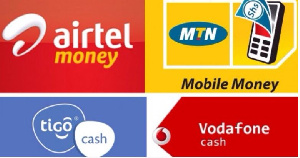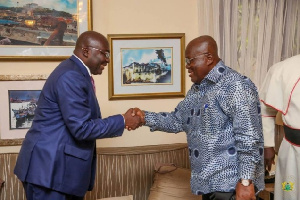Opinions of Saturday, 26 May 2018
Columnist: Bright Simmons
Why Ghana’s telco revenue assurance isn’t working
Government officials in Ghana have been promoting the notion that unless they can count all the calls and measure all the kilobytes of data downloaded on the nearly two dozen or so main-tier telecom companies, they cannot gauge the revenue of these companies correctly and therefore tax them properly.
They say that unlike airline companies, fast food chains and real estate companies, telcos are particularly prone to lie, so they can’t use standard auditing techniques at the GRA (an organisation funded to the tune of $125 million by Ghanaian taxpayers every year) to make sure that they pay the right amount of tax.
It has been explained in remarks on the matter that counting calls, measuring how long they lasted, and metering the number of internet downloads on a network is simply not sufficient to know how much revenue was made because the telecom network operators (telos) have very complex tariff arrangements.
In fact, some of the telco tariff mechanisms change constantly. So in the end, one needs more than just traffic measurement. One also need to know for each kilobyte and each second of each phone call what the telco was *billing* at that precise time.
This is not exactly like counting the number of bottles of adonko bitters produced by Angel every week in order to assess excise tax, even though we don’t do that either.
It has also been explained that of the total tax paid by telcos more than 80% depend more on what costs they declare and less on the revenue they post, so the true benefits of traffic measurement, if any at all, must be focused on a small proportion of the full spectrum of telecom taxes. In fact, we can limit ourselves to Communications Services Tax (CST) and NCA Levy. Some will argue that international traffic falls within this bracket, but in fact, it does not. There are complex international carrier arrangements that make traffic monitoring less effective here too.
The long and short of it is that only about $74 million of telecom taxes a year can be *assured* primarily from monitoring traffic, provided one is willing to trust the telco’s tariff coding and rating engines.
How much is spent collecting this money (“assurance” is merely something you do to help you collect what is due) is thus of very serious importance.
The Ghanaian regulatory authorities have been doing this monitoring thing for years now so it is widely appreciated that the monitoring hasn’t really uncovered much of note. Hence, it is critical to be very conscious of how much is spent on it.
In fact, the tax authorities spend money assuring and monitoring ALL tax revenue. As has been explained in previous remarks on the issue, the Ghana Revenue Authority (GRA) spends at least $125 million on their personnel, systems and capacity to ensure that the $7.5 billion they collect is the most they can get.
To collect $1.23 billion of in company tax from Ghanaian enterprises, the GRA has divisions that focus on corporate taxation, including even a “large taxpayers unit”. From my assessment, the total cost of assurance and monitoring of this $1.23 billion is about $24 million (still refining the calculus though).
In short, for every cedi collected from companies or individuals in Ghana, the authorities spend less than 2 pesewas. This is still double what the UK tax authorities spend per sterling raised though, but it is what it is.
The argument that has arisen is whether the telecom industry is a) that corrupt and b) that flush with hidden cash to warrant the industry being treated as a special case and the authorities spending far more than 2 pesewas for each cedi collected.
To reemphasise, Ghana has been spending about $32 million to protect $74 million in recent times. Even if we concede the argument that international call tax can be equated to CST and add NCA levy, the total tally of relevant taxes still amount to only $200 million thereabouts. But as has already been hinted, “international terminating” traffic has systems for cross-checking that make direct monitoring ineffective. Let’s leave it there.
Should the Ghanaian tax authorities spend 40 pesewas for every hundred pesewas of telecom taxes the country raises?
The activists of the Government of the day make two arguments that deserve some consideration.
There is a possibility that as new services come out of this industry, more opportunities to tie the country’s tax take directly to the revenues of the telcos will arise. Thus that $74 million could grow severalfold.
Government has reduced the cost of monitoring, so, as a percentage of the total tax take, the country’s cost of collection will correspondingly go down.
In simple terms: it is additional money. If Ghana can raise more money than it could have done without monitoring then even if the cost of doing so is 90% of the amount raised, it is still new money.
Firstly, it is not entirely clear that the government has really saved money on the new deal for telecom revenue assurance that it has signed with KelniGVG.
Yes, it has cancelled the contract of one of two companies that were doing stuff in this space – Subah. And it says it has reduced the scope of what Afriwave, the other company involved in assurance, does.
But it is a widely known fact that Afriwave has a long-term contract that entitles it to fees that still have to be paid. The “interconnect” services it is providing are also only useful if they succeed in preventing under declaration of revenues because otherwise, the telcos would have continued to do it themselves. Indeed, the interconnect regime was foisted on the industry with this very justification. So this is another cost imposed for revenue assurance.
We also know that the government intends to continue paying $18 million a year to a new company – KelniGVG – for this assurance business. So, it is safe to say that Ghana is going to keep spending at least $30 million a year. That fact is a given. The reader can thus ignore point B above. Let’s focus on point A.
For the government to use these monitoring services to raise more money than they ordinarily would have, and thus make discussions about costs redundant, the LOGIC of how these services work needs serious analysis. Because otherwise, all that would be happening is the authorities taking a huge chunk of taxes raised and passing it on to a Haitian company with a Ghanaian face.
So, let’s dispel some misconceptions:
No, the contractors that the government of Ghana has been engaging so far DON’T actually have the capacity to directly count every call made on every network, measure how long it took, and weigh every byte of data downloaded on every network, from Blu to Globacom. Let’s throw that misguided propaganda away.
To do that directly, on the live networks as they claim they have been doing, independent of the telcos’ own systems, they would have to deploy hardware gateways into the physical network and circuit switching systems and build their own mediation hub. None of the companies Ghana has engaged so far remotely has that kind of capacity, and the costs would be humongous. In fact, if this was what was going down, the likes of Huawei, NSN, Comviva Mahindra etc would have been the names Ghanaians would have been hearing. That kind of feat is not a joke.
The telecoms have mediation software sitting in their core network operations centres that collect the data from their switches and gateways across their network, which in turn pool data from thousands of cell sites across the country. This software receives and translates raw data into auditable logs called UDRs or EDRs or CDRs, depending on what framing of the activity is valid at a particular time. These logs are what the telcos themselves use for their own revenue analysis.
What has been happening in Ghana, especially since 2015, is that the country has been hiring companies that lack the capacity to design APIs to comprehensively interface with the elaborate telco mediation software and thus receive granular logs in a lightweight format for their interpretation software? So apparently the data gets sent offline in excel format, which these contractors claim they then import into some software sitting on servers in their data centres. It is these servers that Ghanaian government officials keep calling “probes”, “machines” etc.
The current position of the government is that they intend to enable online interfacing with the mediation software of the telcos.
The question then becomes:
Does that make a substantial difference?
How much should that cost?
It can be conceded that this reduces the likelihood of errors on the part of the companies doing the parallel tabulation. So in that sense, it may be an improvement.
But it still depends on the contractor relying on the telcos’ rating systems.
That is why they now say they want to take data a bit more downstream by collecting actual billing reports.
What is curious is that we are now happy to trust telcos’ billing reports when we were worried that they could “under-declare” the more granular CDRs that they were giving for free to the telecom regulators and the tax authorities (GRA).
Be that as it may, how much should this cost if done properly?
It is simple. One just needs to look at the commercial services available for interpreting low-level telco data.
Example: WebCDR:
http://www.webcdr.com/
And SAAS solutions that do exactly the same thing, like Mahindra Comviva’s:
https://www.techmahindra.com/…/so…/Pages/Platforms/baas.aspx
These types of solutions are so generic that they are now available as open-source products and SAAS solutions with no need for the buyer to invest money upfront.
If the GRA and NCA really just want additional insight into rating and billing in order to spot anomalies, they could start with simple off the shelf CDR analytics solutions and then commission custom modules as they get better at it. And there are clever ways of spotting anomalies if one truly understands what one is looking for.
As has been said already it is primarily a matter of trained manpower in the revenue assurance teams of the GRA.
I don’t see how anyone can justify spending more than $1.5 million per year on personnel, training, and software for revenue monitoring and assurance in this context. This assertion is based on both benchmarking and direct bill of quantities modelling.
Firstly, based on the proportion of company taxes paid by telcos, Ghana should already be spending at least $10 million of the funds its taxpayers give to the GRA annually on telecom revenue assurance. The question, therefore, is how much more should the country sacrifice in the hope of additional revenue?
Given the track record of revenue performance in the past after the authorities have spent millions of dollars on CST monitoring, let’s assume that the most they can do are to DOUBLE the CST revenue. If so, then they should use the 2% of revenue raised as the appropriate cost benchmark. Which is how I arrive at the $1.5 million quoted above.
But knowing what I know of public procurement in these parts, I can see why such thinking is likely to pose challenges in the corridors of power.











